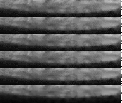 |
Figure 2: An image with 6 frames of the edge of the Moon obtained without the anamorphic relay |
It is also well known
that in the CCD the matrix of pixels is sent, one row at a time, to the
serial register where the pixels are read sequentially.
While the process of shifting each row or each pixel
is very fast (of the order of 10-7 s)
in our low cost interface there is
a bottleneck due to the A/D conversion of each pixel.
In order to freeze the effect of the atmosphere on the images
of the lunar edge, it is necessary to overcome this limit.
We adopted the approach of using a frame transfer technique
so that more images of the Moon are
collected in the same frame and it is possible to have an
equivalent frame rate of roughly 20 Hz.
The edge of the Moon is imaged in n of the lines which are
on the side of the CCD opposite to the serial register.
Here n is the number of rows of the CCD over the number of images
of the Moon that we want to have on the same frame, s.
After the first exposure (of the order of t=50 msec),
the image of the edge is shifted of n lines,
which are then discarded.
After s exposures, on the matrix there are s different images
of the edge of the Moon (Fig. 2)
and the pixels can now be converted into digital data.
In addition, for some of the measurements performed
in this experiment, an anamorphic optical relay
is inserted between the focus of a the Schmidt-Cassegrain
telescope and the CCD.
It is known (Laikin 1973) that in the CinemaScope system,
using a conventional 35 mm cinematographic film, the image projected
is twice wider than its height.
This is achieved by placing an anamorphic objective after the objective of
the projector. The anamorphic objective is an afocal optical system usually
made of cylindrical lenses: it shortens the focal length of the main
objective in one nodal plane while leaving unchanged the focal length in
the complementar direction.
To avoid any problem of astigmatism, due to the presence
of cylindrical lenses,
the anamorphic objective should work in collimated light.
The anamorphic relay used in this experiment
is made of a cylindrical tube (see Fig. 3)
in which a 50 mm camera objective (collimator), the anamorphic objective
and another 58 mm camera objective take place.
Copyright The European Southern Observatory (ESO)